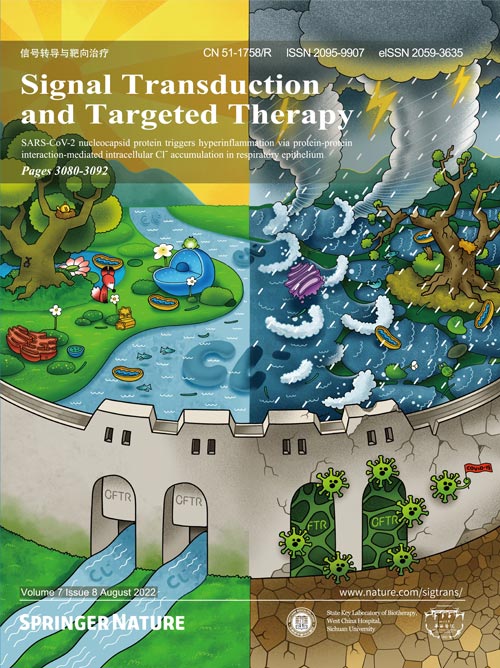Volume 7 Issue 8, Aug 2022:
Article
SARS-CoV-2 nucleocapsid protein triggers hyperinflammation via protein-protein interaction-mediated intracellular Cl− accumulation in respiratory epithelium
Lei Chen
ORCID: orcid.org/0000-0002-9488-1173,Wei-Jie Guan,Zhuo-Er Qiu,Jian-Bang Xu,Xu Bai,Xiao-Chun Hou,Jing Sun,Su Qu,Ze-Xin Huang,Tian-Lun Lei,Zi-Yang Huang,Jincun Zhao
ORCID: orcid.org/0000-0003-2515-5589,Yun-Xin Zhu,Ke-Nan Ye,Zhao-Rong Lun,Wen-Liang Zhou
ORCID: orcid.org/0000-0001-9124-3144,Nan-Shan Zhong &…Yi-Lin Zhang
ORCID: orcid.org/0000-0001-5350-8279
SARS-CoV-2, the culprit pathogen of COVID-19, elicits prominent immune responses and cytokine storms. Intracellular Cl− is a crucial regulator of host defense, whereas the role of Cl− signaling pathway in modulating pulmonary inflammation associated with SARS-CoV-2 infection remains unclear. By using human respiratory epithelial cell lines, primary cultured human airway epithelial cells, and murine models of viral structural protein stimulation and SARS-CoV-2 direct challenge, we demonstrated that SARS-CoV-2 nucleocapsid (N) protein could interact with Smad3, which downregulated cystic fibrosis transmembrane conductance regulator (CFTR) expression via microRNA-145. The intracellular Cl− concentration ([Cl−]i) was raised, resulting in phosphorylation of serum glucocorticoid regulated kinase 1 (SGK1) and robust inflammatory responses. Inhibition or knockout of SGK1 abrogated the N protein-elicited airway inflammation. Moreover, N protein promoted a sustained elevation of [Cl−]i by depleting intracellular cAMP via upregulation of phosphodiesterase 4 (PDE4). Rolipram, a selective PDE4 inhibitor, countered airway inflammation by reducing [Cl−]i. Our findings suggested that Cl− acted as the crucial pathological second messenger mediating the inflammatory responses after SARS-CoV-2 infection. Targeting the Cl− signaling pathway might be a novel therapeutic strategy for COVID-19.
